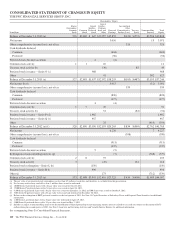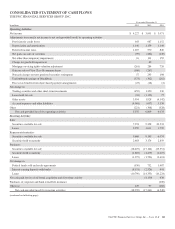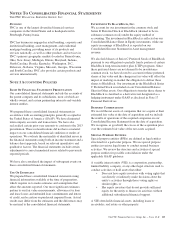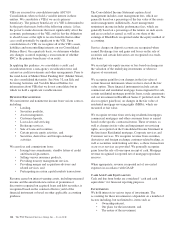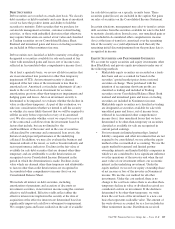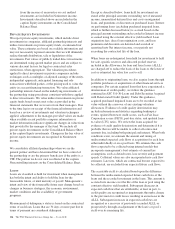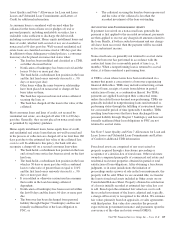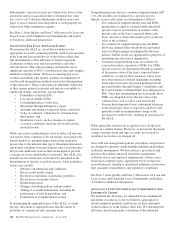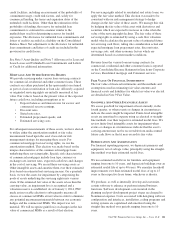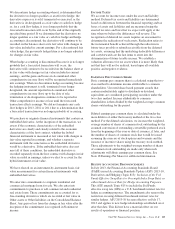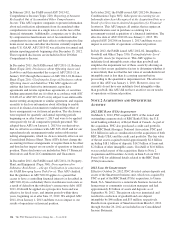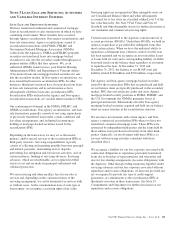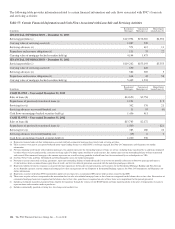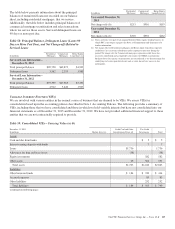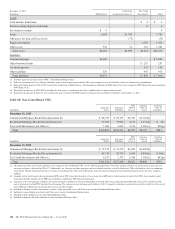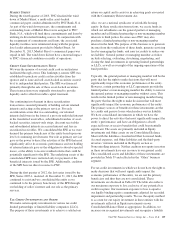PNC Bank 2013 Annual Report Download - page 137
Download and view the complete annual report
Please find page 137 of the 2013 PNC Bank annual report below. You can navigate through the pages in the report by either clicking on the pages listed below, or by using the keyword search tool below to find specific information within the annual report.Asset Quality and Note 7 Allowances for Loan and Lease
Losses and Unfunded Loan Commitments and Letters of
Credit for additional information.
A consumer loan is considered well-secured when the
collateral in the form of liens on (or pledges of) real or
personal property, including marketable securities, has a
realizable value sufficient to discharge the debt in full,
including accrued interest. Home equity installment loans and
lines of credit, whether well-secured or not, are classified as
nonaccrual at 90 days past due. Well-secured residential real
estate loans are classified as nonaccrual at 180 days past due.
In addition to these delinquency-related policies, a consumer
loan may also be placed on nonaccrual status when:
• The loan has been modified and classified as a TDR,
as further discussed below;
• Notification of bankruptcy has been received and the
loan is 30 days or more past due;
• The bank holds a subordinate lien position in the loan
and the first lien loan is seriously stressed (i.e., 90
days or more past due);
• Other loans within the same borrower relationship
have been placed on nonaccrual or charge-off has
been taken on them;
• The bank has repossessed non-real estate collateral
securing the loan; or
• The bank has charged-off the loan to the value of the
collateral.
Most consumer loans and lines of credit, not secured by
residential real estate, are charged off after 120 to 180 days
past due. Generally, they are not placed on nonaccrual status
as permitted by regulatory guidance.
Home equity installment loans, home equity lines of credit,
and residential real estate loans that are not well-secured and
in the process of collection are charged-off at no later than 180
days past due to the estimated fair value of the collateral less
costs to sell. In addition to this policy, the bank will also
recognize a charge-off on a secured consumer loan when:
• The bank holds a subordinate lien position in the loan
and a foreclosure notice has been received on the first
lien loan;
• The bank holds a subordinate lien position in the loan
which is 30 days or more past due with a combined
loan to value ratio of greater than or equal to 110%
and the first lien loan is seriously stressed (i.e., 90
days or more past due);
• It is modified or otherwise restructured in a manner
that results in the loan becoming collateral
dependent;
• Notification of bankruptcy has been received within
the last 60 days and the loan is 60 days or more past
due;
• The borrower has been discharged from personal
liability through Chapter 7 bankruptcy and has not
formally reaffirmed his or her loan obligation to
PNC; or
• The collateral securing the loan has been repossessed
and the value of the collateral is less than the
recorded investment of the loan outstanding.
A
CCOUNTING FOR
N
ONPERFORMING
A
SSETS
If payment is received on a nonaccrual loan, generally the
payment is first applied to the recorded investment; payments
are then applied to recover any charged-off amounts related to
the loan. Finally, if both recorded investment and any charge-
offs have been recovered, then the payment will be recorded
as fee and interest income.
Nonaccrual loans are generally not returned to accrual status
until the borrower has performed in accordance with the
contractual terms for a reasonable period of time (e.g., 6
months). When a nonperforming loan is returned to accrual
status, it is then considered a performing loan.
A TDR is a loan whose terms have been restructured in a
manner that grants a concession to a borrower experiencing
financial difficulties. TDRs may include restructuring certain
terms of loans, receipts of assets from debtors in partial
satisfaction of loans, or a combination thereof. For TDRs,
payments are applied based upon their contractual terms
unless the related loan is deemed non-performing. TDRs are
generally included in nonperforming loans until returned to
performing status through the fulfilling of restructured terms
for a reasonable period of time (generally 6 months). TDRs
resulting from borrowers that have been discharged from
personal liability through Chapter 7 bankruptcy and have not
formally reaffirmed their loan obligations to PNC are not
returned to accrual status.
See Note 5 Asset Quality and Note 7 Allowances for Loan and
Lease Losses and Unfunded Loan Commitments and Letters
of Credit for additional TDR information.
Foreclosed assets are comprised of any asset seized or
property acquired through a foreclosure proceeding or
acceptance of a deed-in-lieu of foreclosure. Other real estate
owned is comprised principally of commercial real estate and
residential real estate properties obtained in partial or total
satisfaction of loan obligations. After obtaining a foreclosure
judgment, or in some jurisdictions the initiation of
proceedings under a power of sale in the loan instruments, the
property will be sold. When we are awarded title, we transfer
the loan to foreclosed assets included in Other assets on our
Consolidated Balance Sheet. Property obtained in satisfaction
of a loan is initially recorded at estimated fair value less cost
to sell. Based upon the estimated fair value less cost to sell,
the recorded investment of the loan is adjusted and, typically,
a charge-off/recovery is recognized to the ALLL. We estimate
fair values primarily based on appraisals, or sales agreements
with third parties. Fair value also considers the proceeds
expected from government insurance and guarantees upon the
conveyance of the other real estate owned (OREO).
The PNC Financial Services Group, Inc. – Form 10-K 119



